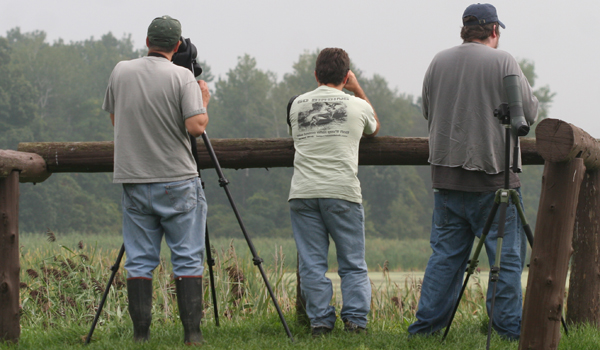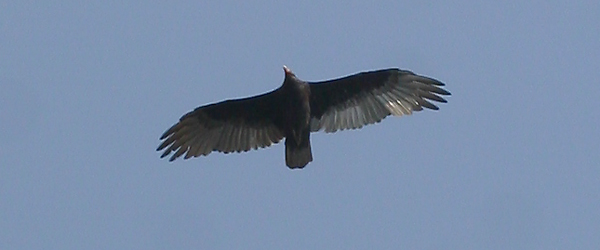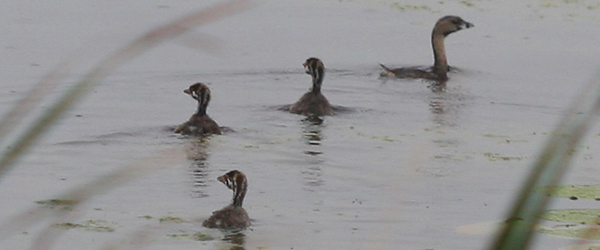Though Mike has already put up a post about our Montezuma Muckrace experience so much happened during the loooong day of birding that there is plenty more to post. It was a great day and Will, Jory and Mike were tenacious teammates: it’s unusual for four people, much less birders, to be in a somewhat stressful situation (trying to achieve a goal of seeing at least 100 birds and having a tough time of it) to manage to not have a single argument but we managed it. And when we found a cool caterpillar and Mike suggested I grab my camera from the car for some macro pics and it turned out my camera was not in the car, well, the stress level went up a couple of notches but I think I handled myself remarkably well (the sobbing, crying and gnashing of teeth were done behind some bushes where they couldn’t see me).
three of the four Butcher Birders (I was behind the camera before I lost it)
It was the second time that I left the same camera behind: last time was also with Jory and Will. And, like last time, there was a happy ending. A nice gentleman (who must be a birder) found the camera and turned it in and I was able to recover it the next morning. So I did not get as many pictures of the day as I would have hoped but at least I got my camera back (yes Jory, I have put a name and address label on it now).
Anyway, it was a great day but what I am interested in is what would have made it better (besides not losing track of my possessions)? And the answer, of course, is more birds! But how could we have found more birds? We came up with several ideas…
unlike in NYC we saw many Turkey Vultures upstate
First of all, we needed more familiarity with the area. Thirty-four thousand acres is a lot of ground to cover and birds are typically rather small, so figuring out where they are in advance is helpful. The little scouting that Jory, Will and I did paid off and if we had only had a bit more time to scout I’m sure we could have picked up a few more species. Other teams tracked down Virginia Rail, Mute Swan, Northern Mockingbird, and Red-breasted Nuthatch; all birds that typically find a spot they like and stay put. If we had known where those spots were I’m sure we would have found the birds. We also barely visited the northern end of the area, simply because we had no idea where to go or what we could see if we did. In practice this meant that about one-third of the area was completely ignored.
We also should have spent more time walking and less time driving. On Howland’s Island especially we drove the back roads stopping at likely spots or when we heard or saw birds moving but we would likely have been more successful at tracking down flocks of neotropical migrants if we had just parked the car and walked a planned-out route. While everyone has seen good birds from cars one is much more likely to see and hear more when not in a vehicle.
good birds we did see from the car: an adult and three juvenile Pied-billed Grebes
We also should have been more patient when we did come across birds. We would find a flock of chickadees, titmice, and woodpeckers and if something else didn’t materialize within a minute or two we moved on to another spot. I think a bit more patience could have resulted in our tallying more than four species of wood-warbler.
Despite our lack of scouting we did, after all, track down 102 species of bird and managed to raise $223.50 for Friends of the Montezuma Wetlands Complex. And, like Will, I will never forget the sight and sound of Jory dancing and screaming with joy while standing on the front seat of the car with the upper half of his body sticking out of the sunroof when the Sandhill Cranes flew past.
The Montezuma Muckrace itself was a well-run event with a fun and rewarding closing ceremony. And while we did not finish in first, or even in the top three, I still felt victorious when we piled in the car and headed back to Mike’s house for some well-deserved rest on Saturday night. Many thanks to Mike for hosting us, to Jory for volunteering his car and the indefatigable Lola, to Will for putting the rudiments of our route together, to all those who pledged cash through our team, and to all of the volunteers and other participants who make the Montezuma Muckrace, New York’s finest birding event, possible.
















Hey Corey I got a new idea for your next quiz, The Diabolical Birder Quiz. That’s right, you put up a random piece of clothing a bird watcher was wearing and then your loyal readers have to guess who the birder is!
Also for those who are interested by my calculations (and math is a fuzzy subject to me) over 80% of our species we found either in and around the Main Pool at Montezuma or at Howland’s Island. Two stops for over 3/4 of our total.